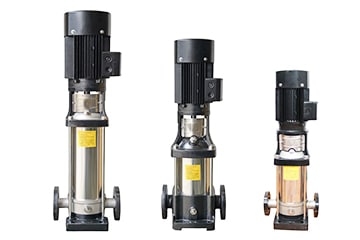Vertical centrifugal pumps are one of the main types of vertical pumps, which are typically used to pump liquids from deep tanks, troughs or wells. They all have a unique vertical configuration that moves liquids upward vertically through piping and can be used for a wide range of operating temperatures, varying pressures, and a wide range of liquids.
AOBL is a leading manufacturer of vertical centrifugal pumps. We are committed to designing and developing comprehensive and effective pumping solutions. AOBL supplies vertical chemical pumps, vertical multistage pumps, submersible sewage pumps and inline pumps.
vertical centrifugal pump types
Vertical centrifugal pumps have vertically oriented shafts. The shaft is designed to be radially split and overhanging. Vertical centrifugal pumps are coupled to an electric motor. The impeller is connected via a shaft to the electric motor, which rotates at a predetermined speed and produces a centrifugal effect.
The robust construction of these pumps avoids the use of internal mechanical seals. The mechanical seals are usually interchangeable. The unique construction and design allows for reliable continuous operation and ensures a long service life.
Vertical multistage pumps
Vertical multi-stage pumps are mechanical devices that can convey liquids from tap water to industrial liquids. It adopts standard vertical motor and quick-fit mechanical seal, which is very easy to replace. The overflow parts of the pump are made of stainless steel (304 or 316), which can be suitable for mildly corrosive media.
Vertical chemical pumps
For the need to transport acid and alkali liquid applications, the site is a deep tank, pool or tank, then you need a vertical chemical pump to transport. Because usually horizontal chemical pumps, either centrifugal pumps or magnetic pumps, do not have good performance in such sites. Vertical chemical pumps can be customized in length to meet the needs according to the site conditions.
Vertical turbine pumps
Vertical turbine pumps are commonly used as centrifugal pumps for transferring water from deep underground pits or wells. They consist of a motor, discharge head, one or more pipe columns, spools, pump shafts, multiple drums, impellers, and suction covers. Particularly suitable for clean water applications requiring high pressure and high head applications.
Vertical Sewage Pumps
Submersible sewage pumps have independent discharge, semi-open or closed impellers and are designed for wet pit applications. The pump has a separate discharge pipe and support column. They are suitable for industrial applications, pumping clean or lightly contaminated fluids, fibrous slurries and liquids containing large solids from deep pits.
Vertical Submersible Well Pumps
A submersible pump, also known as a well pump, is a device with a sealed motor that is tightly coupled to the pump body. It can be completely submerged in water. It is typically used to transfer liquids deep underground, such as in sewage systems. With the development of new energy photovoltaic industry, deep well solar water pump is now widely used.
vertical centrifugal pump vs horizontal centrifugal pump
- Different structure: vertical and horizontal structure.
- Different uses: Vertical centrifugal pumps are used for conveying clear water and other liquids with physicochemical properties similar to that of clear water, and are suitable for industrial and urban water supply and drainage. Horizontal centrifugal pumps for the transportation of solid particles, corrosive, viscosity similar to water liquid.
- Connection form is different: vertical pumps for the bottom-up stacked connection form, horizontal pumps for the left and right longitudinal arrangement and the base.
- Occupies a different space: because the vertical centrifugal pump is vertical structure, vertical pumps do not need much space. Horizontal centrifugal pump is a horizontal structure, so in the footprint than the vertical pump is much larger.
- Installation form is different: vertical and horizontal these two different structures will also make their installation methods are different. For example: vertical pump for the whole connection, installation is very simple. Horizontal pumps also need to be installed after the precision adjustment.
- Maintenance difficulty is different: vertical pump overhaul is difficult, such as overhaul of the impeller needs to be removed from the upper part of all before you can carry out; and the horizontal pump is relatively easy.


